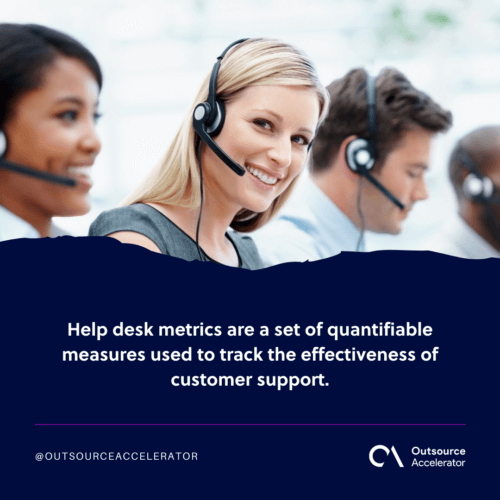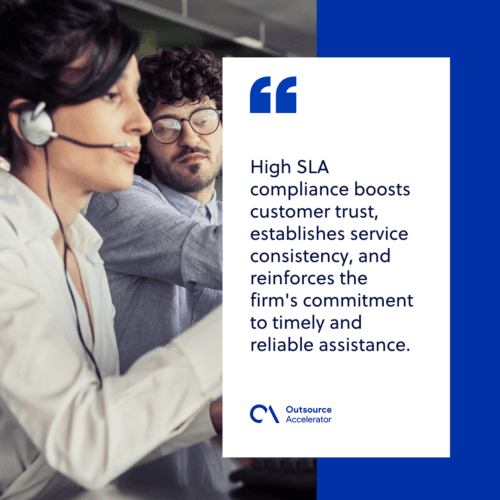10 help desk metrics you should track to boost customer support

Customer support has become crucial for businesses to retain customer satisfaction and loyalty. So keeping track of your help desk metrics is essential to provide the best support possible.
A MediaPost report revealed 84% of customers want to be treated like a person — not just a ticket. Help desk metrics allow for that needed personalization.
Monitoring service desk performance is crucial for enhancing customer support.
Firms like 123Employee employ these to ensure that their staff remains at the top of their game.
But which help desk metrics should you monitor? This article lists down ten help desk metrics you should track and how to record them effectively.
What are help desk metrics?
Help desk metrics are a set of quantifiable measures used to track the effectiveness of customer support.
These benchmarks provide insights into how well your help desk and customer support team is performing.
By tracking these metrics, you’ll clearly understand the quality of support being provided to your customers.
It makes you better equipped to optimize your operations to meet client needs.
Help desk vs. Service desk vs. KPIs
Before delving into the specific metrics, let’s clarify the distinction between a help desk and a service desk.
In IT support, it is important to differentiate between help desks, service desks, and Key Performance Indicators (KPIs) to ensure effective operations and exceptional customer support.
While both terms are often used interchangeably, they serve different organizational purposes.
A help desk primarily focuses on resolving technical issues and providing immediate customer assistance.
It’s a centralized point of contact where clients can seek support for product or service-related queries.
On the other hand, a service desk encompasses a broader scope. It incorporates incident management, problem management, and change management processes.
Key performance indicators (KPIs) are measurable values that gauge the effectiveness and efficiency of help desk or service desk operations.
They offer valuable insights into the performance of help desk teams. KPIs enable companies to make data-driven decisions for process improvements.
When it comes to measuring performance, service desk metrics play a vital role in evaluating efficiency and customer satisfaction levels.

10 help desk metrics to monitor
Tracking and analyzing various help desk metrics is vital to ensure effective customer care.
By regularly tracking these metrics, the customer service team can identify trends, areas for improvement, and opportunities to enhance customer experiences.
Let’s explore ten essential benchmarks that can significantly impact consumer satisfaction and support team performance.
1. Ticket volume
Ticket volume is the total number of support tickets received within a specific period. It provides an overview of the workload and customer demand the help desk faces.
Monitoring ticket volume helps identify trends, spikes, or patterns in customer inquiries. Plus, it allows for resource allocation and capacity planning.
2. First response time
First response time measures the average time support agents take to respond to tickets for the initial interaction.
It reflects the support team’s speed and efficiency in acknowledging and addressing client concerns.
3. Average handle time (AHT)
Average handle time represents the standard duration required to resolve a ticket from when it is received until its closure.
It assesses the support agents’ efficiency in resolving issues while maintaining service quality.
According to HubSpot, the AHT industry standard depends on the communication medium and sector.
4. Customer satisfaction score (CSAT)
Customer satisfaction (CSAT) score is the level of satisfaction experienced by buyers.
It is measured after an interaction with the help desk and is usually obtained through post-interaction surveys or feedback.
It’s essential to always aim for a high CSAT score by delivering exceptional customer support.
A high CSAT score indicates a positive customer experience, while a low score highlights areas that require improvement.
Utilizing customer satisfaction surveys helps companies gather valuable feedback to improve their services and products continuously.
5. Net promoter score (NPS)
Net promoter score (NPS) is widely used to gauge customer loyalty and advocacy. It assesses the likelihood of clients recommending a company’s product or service to others.
Like CSAT, NPS typically uses surveys. A higher NPS indicates stronger customer loyalty and higher chances of positive word-of-mouth referrals.
By measuring how satisfied customers are, NPS helps organizations understand their strengths and areas for improvement.
Monitoring NPS regularly and acting on feedback received can help companies build stronger relationships with their customers and drive continuous improvement in their support services.
6. First contact resolution (FCR) rate
First contact resolution (FCR) rate measures the percentage of consumer inquiries or issues resolved during the initial interaction without requiring any further follow-up.
Achieving a high FCR rate signifies efficient problem-solving and a seamless support experience.
7. Escalation rate
The escalation rate is the percentage of tickets that need to be escalated to higher-level support or management.
This often happens due to their complexity or severity. Monitoring this metric helps support agents in identifying recurring issues or knowledge gaps.
The escalation rate in the support process is a key metric that reflects service desk performance.
6. Agent utilization rate
Agent utilization rate calculates the time spent actively handling customer tickets. It includes time spent on client interactions, ticket resolutions, and other support-related tasks.
Maximizing agent utilization ensures optimal resource allocation and efficient use of the service team’s capabilities.
7. Cost per ticket
Cost per ticket measures the average cost incurred by an organization for handling each customer support ticket. It covers agent salaries, infrastructure costs, and software expenses.
Tracking the cost per ticket optimizes support operations, reduces costs, and improves profitability.
8. Service level agreement (SLA) compliance
Service level agreement (SLA) compliance weighs how much the support team meets the predefined work targets.
SLAs typically cover response and resolution times for different types of support tickets.
High SLA compliance boosts customer trust, establishes service consistency, and reinforces the firm’s commitment to timely and reliable assistance.
9. Abandoned call rate
Abandoned call rate applies to support channels like phone or live chat. It represents the percentage of customer calls or chat sessions that are prematurely ended or abandoned before resolving.
A high abandoned call rate suggests long wait times or ineffective support. Knowing this highlights areas that require attention to improve customer service.
By tracking this metric, organizations can identify opportunities to optimize their call management systems, increase efficiency, and ultimately enhance customer satisfaction.
10. Repeat contact rate
Repeat contact rate indicates the number of customers who need to contact the help desk multiple times to resolve a single issue.
A high repeat contact rate may show insufficient issue resolution during the initial interaction. It can also indicate a lack of clear communication.
High support requests can often correlate with a lower customer effort score, highlighting potential pain points in the customer journey that may lead to increased repeat contacts.
To address this, optimizing the efficiency of customer support teams is paramount.

How to effectively track help desk metrics
To successfully track help desk metrics and leverage the insights they provide, organizations can follow these best practices:
- Establish specific goals and objectives aligned with your company’s customer support strategy.
- Choose metrics that align with your objectives and use them to inject insights into your help desk operations.
- Use reliable help desk software or a ticketing system that automates metric tracking and reporting.
- Continuously monitor and analyze help desk criteria to identify trends, patterns, and improvement areas.
- Compare your metrics against industry benchmarks and set realistic targets for improvement.
- Ensure help desk agents have the knowledge and tools to deliver exceptional customer service.
- Share the insights gained from metrics with relevant stakeholders and take proactive steps to address areas of improvement.
Implementing data-driven decisions based on these metrics can lead to improved customer satisfaction levels, strengthening relationships with clients and boosting overall customer loyalty.







 Independent
Independent




